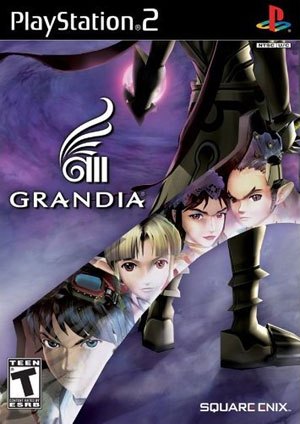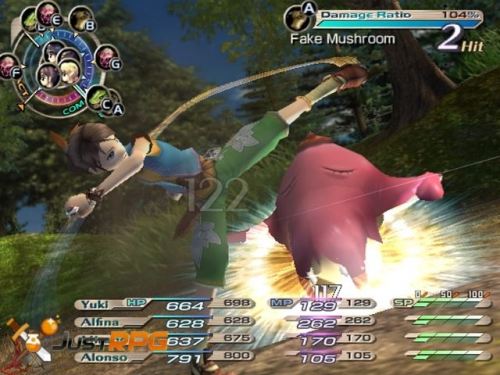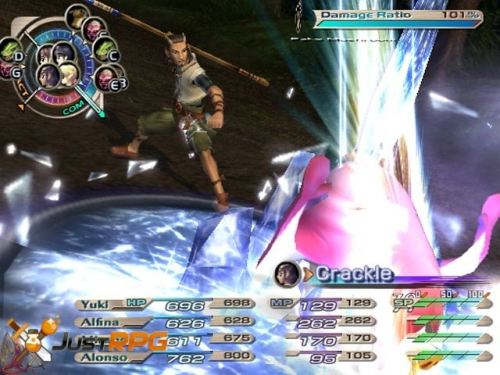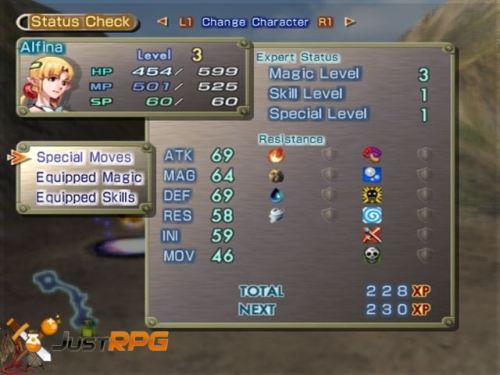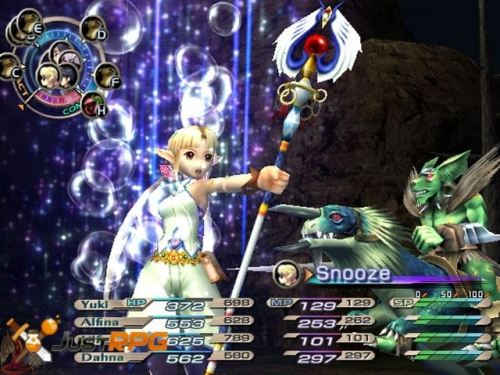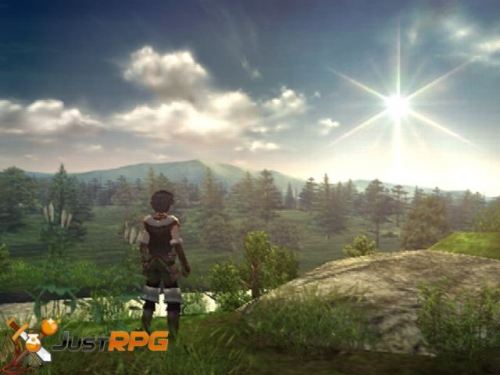Grandia 3
Grandia 3 is a turn based RPG for the PS2. The game improves on many features found in previous Grandia titles including an update to the battle system. The story follows Yuki who is determined to become a great sky pilot. Take to the sky in Grandia 3.
Grandia 3 Overview
Like Skies of Arcadia, Grandia 3 is a RPG with a heavy emphasis on air ships. Its the third game in the Grandia series and has an improved, faster paced combat system. The plot follows an aspiring sky pilot named Yuki and his friends as they attempt to stop a rogue ‘Communicator’ from acquiring the dark powers of Xorn. While the save-the-world story may not be that inspiring, the cast of characters are interesting. Grandia 3 has high production values including nice visuals and a stellar sound track.
Grandia 3 Screenshots
Grandia 3 Featured Video
[youtube]http://www.youtube.com/watch?v=RFhOb04KRus[/youtube]
Grandia 3 Review
By, Aaron Slater
The Grandia series has had its ups and downs, with some solid installments, some lackluster ports, and an interesting dungeon crawler spin-off back in 2002. After four years with no new installments, it was surprising to see Grandia III obtain such a high-profile stateside release, but one has to wonder whether the wait has been worth it.
Grandia III is unquestionably a gorgeous game. The backgrounds and environments that the player will traverse are gorgeously decorated, with different towns and locales having different architectural styles. At times, just exploring the areas and seeing the sun burst through the trees and glow in the distance as you explore a forest is a reward in itself. The characters are all well designed, but they do look a bit dated. Still, one cannot help but imagine that this was a style choice, as the characters in all the Grandia games have carried this similar style.
In battle, the game still looks amazing. The character and enemy animations are all well done, while staying true to the series’ roots. Expect to see some of the enemies from previous Grandia games looking even better than they did. Special attacks and spells all look gorgeous and are highly detailed. Even better than the battle graphics and animations are the cut scenes, which keep with the style of the game while being immaculately clean and detailed. Grandia III, at the very least, is easy on the eyes.
Aurally, Grandia III is also a success. The soundtrack is very nice, with some very fun pieces that coincide with the environments and events. Unfortunately, none of the actual tracks are all that memorable. Instead they all kind of blend together to form an adequate backing track. The sound effects and such are nice, with spells and attacks sounding accurate. Ambient noise that accompanies some of the environments and locales also works well in bringing the world to life. The voice-overs that are present in the game are all very well done, with the voices fitting both the characters and the situation at hand.
The graphics and audio all lend a helping hand to Grandia III’s storyline, which is unfortunately both its greatest success and largest downfall. The story of Grandia III is quite simple. Yuki, an adolescent who dreams of flying planes like his hero, and his mother Miranda, encounter a young girl who is being chased by some nasty soldiers. The three of them decide to escort her to where she needs to go and protect her whilst they do. Little do they realize that their journey gets them deeply involved in the fate of the world. The game initially seems to offer quite a bit, giving us villains that range from bumbling to mysterious, and heroes that are heavily elaborated on. Unfortunately, the game never fulfills its initial promise, and it becomes all too predictable as it winds to a conclusion. This is not necessarily a bad thing, however; quite the contrary, as following the characters and watching them grow and develop is well worth the price of admission. Watching the interactions between Miranda and Yuki are entertaining and heartwarming, and seeing how each character changes and grows over the course of the adventure is more interesting than saving the world at some points.
Fortunately, to help liven up the “saving the world” bits is the incredible battle system. The Grandia series has prided itself upon its battle system, and Grandia III has the best iteration of this system yet. Enemies can be seen on the filed screen, and engaged by running into them. If the player wants to score the upper hand, the enemies can be attacked, first sending them into a stunned state, and then they can be touched to engage in battle with a bit of a lead. By the same token, if an enemy encounters a player from behind, the enemy will have the upper hand. All of these come into play through the remarkable battle system. In the corner of the screen lies the IP gauge, a circle that has icons for the party and the enemies. The icons move around the circle until they reach the “COM” area. At this area, the player can command the character to use a combo (normal attack), use a critical hit (to cancel an enemy’s attack), use a special move, use an item, use magic, escape, defend, use the special skill of a weapon, or set strategy (in case one does not want to directly control their party). Using a normal attack instantly allows the character to charge at the enemy and attack, while using almost anything else requires a wait time, in which the icon will continue to move until it reaches the “ACT” bar, which is where the character will carry out the command. While in this space between the “COM” area and the “ACT” area, the character’s move can be interrupted by an enemy attack and the wait can be slowed down or even stopped entirely. However, if a character uses a cancel-type attack to an enemy who is waiting to carry out a special move, the enemy can be stopped as well. In theory it sounds a little complex, but when the battles are actually going on, they are fast paced and frenetic, as characters and enemies carry out attacks, attacks are canceled, and havoc is wreaked. The battle system is much faster than in previous entries, and the enemies tend to offer a bit of a challenge, while some boss battles can have the party fighting for quite some time.
Outside of battle is the character customization. Characters will level up when enough experience is gained, but also expert status levels can increase as well depending on which actions are used in battle. Magic, Skill, and Special are the three expert status levels. By leveling up the magic or skill expert level, more spells or skills can be equipped, while when the special level increases, the amount of SP available to a character increases. SP correlates to character-specific special attacks that each character can use, and is constantly gained through attacking in battle, while MP is drained by using spells and can only be recovered by resting or using an item. This system sounds simple, but it does aid in character customization by specializing characters a bit more.
Further customization comes in the form of skill books and mana eggs. Skill books augment the power of various types of skills, whether mind-type skills, technique-type skills, or body-type skills. The skill book makes the equipped skills of each type more powerful than it would have been before, and if used properly can help to turn a character into a powerhouse. Mana eggs work on a similar level, as they correlate to an element of magic. When a spell of the corresponding element is attached, its power increases and it becomes much more useful in battle. Skill books and mana eggs can also have skills and magic that can be extracted from each of them, for a fee of course. All in all, this adds to some fun customization of characters that can help to better accommodate the party for the challenges they will face.
The challenges faced in Grandia III are a mixed bag. The game is challenging, and boss battles can last for quite some time regardless of how prepared the party is, but the game never offered too much raw difficulty, which may be a good thing or a bad thing depending on the player. Grandia III is also very linear with very few side quests and optional objectives along the way. One can expect to follow their quest from location to location, with backtracking being completely optional, for about thirty hours, and unfortunately this thirty-hour quest is not without its pacing issues. The game offers many opportunities for battle, but at times the dungeon and exploration parts of the game are spaced out by large portions of story. The story segments are not bad, but when they drag on for an hour or two with little opportunity for exploration or to use the insanely fun battle system, it can be quite grating.
Overall, Grandia III is certainly a game that holds a lot of promise. What it lacks in an original storyline and length, it more than makes up for with its gorgeous graphics, interesting characters, and polished to perfection battle system. While it might not be too difficult nor have much to offer besides the main quest, it’s hard to be too turned off by the flaws when the game is just a lot of fun to play. Grandia III might not be the epic installment that fans were hoping for, but it offers a great role-playing experience that fans and newcomers should definitely try out.
Final Grade: 86%
Grandia 3 Videos
Grandia 3 Official Trailer
[youtube]http://www.youtube.com/watch?v=RFhOb04KRus[/youtube]

